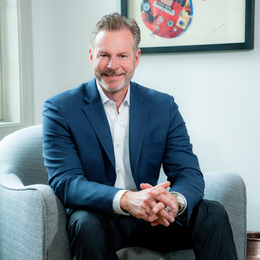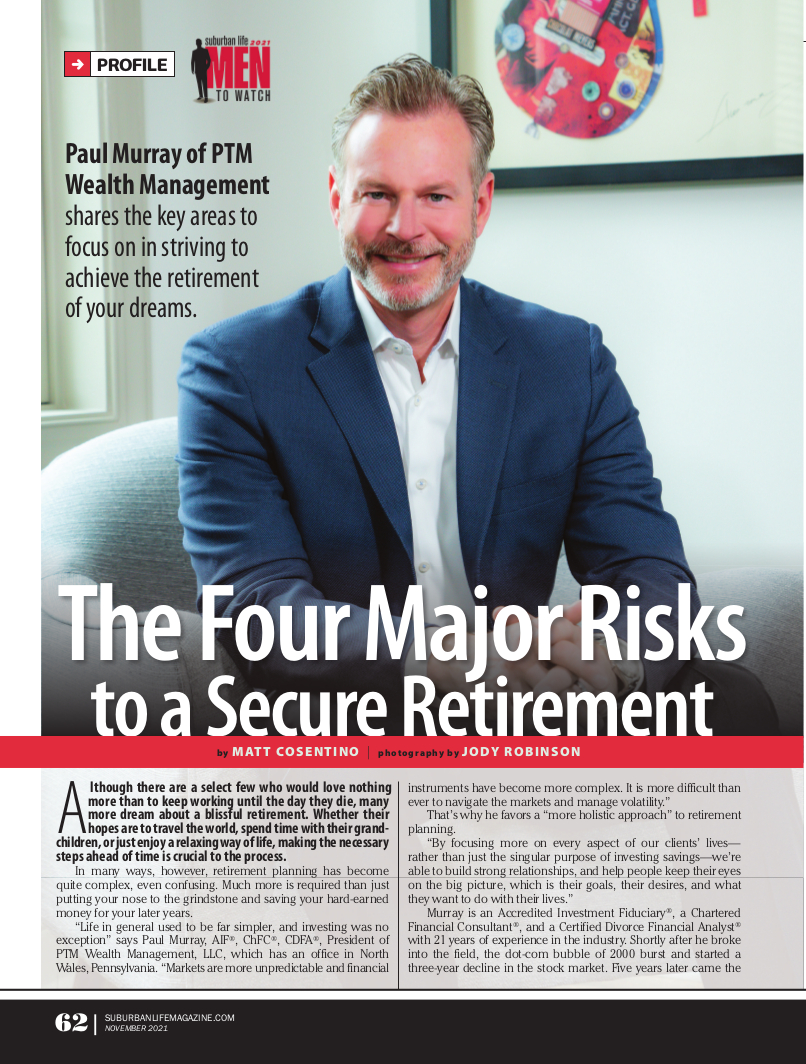
The Four Major Risks to a Secure Retirement
Paul Murray of PTM Wealth Management shares the key areas to focus on in striving to achieve the retirement of your dreams.
Although there are a select few who would love nothing more than to keep working until the day they die, many more dream about a blissful retirement. Whether their hopes are to travel the world, spend time with their grandchildren, or just enjoy a relaxing way of life, making the necessary steps ahead of time is crucial to the process.
In many ways, however, retirement planning has become quite complex, even confusing. Much more is required than just putting your nose to the grindstone and saving your hard-earned money for your later years.
“Life in general used to be far simpler, and investing was no exception” says Paul Murray, AIF®, ChFC®, CDFA®, a President of PTM Wealth Management, LLC, which has an office in North Wales, Pennsylvania. “Markets are more unpredictable and financial instruments have become more complex. It is more difficult than ever to navigate the markets and manage volatility.”
That’s why he favors a “more holistic approach” to retirement planning.
“By focusing more on every aspect of our clients’ lives—rather than just the singular purpose of investing savings—we’re able to build strong relationships, and help people keep their eyes on the big picture, which is their goals, their desires, and what they want to do with their lives.”
Murray is an Accredited Investment Fiduciary®, a Chartered Financial Consultant®, and a Certified Divorce Financial Analyst® with 21 years of experience in the industry. Shortly after he broke into the field, the dot-com bubble of 2000 burst and started a three-year decline in the stock market. Five years later came the recession of 2008, the greatest financial crisis since the Great Depression.
Both events had a monumental effect on Murray’s approach to serving his clients.
“I learned a lot about the fragility of the financial system and how it could derail retirement plans,” he says. “It’s been 12 years since we’ve had a recession, and we’ll see more in our lifetimes. I believe if investors stop focusing so much on investment returns and what the market owes them, and think more about problem-solving, planning, and having their money fund the things that matter most to them, they will become more successful.”
Murray regularly offers a free, two-night course at universities in southeastern Pennsylvania titled, “The Changing World of Retirement Planning.” The class centers on what he has identified as the four major risks to a secure retirement.
1. Tax rate risk. In recent years, Murray has taken the unique stance of placing a high emphasis on taxation in retirement. With the national debt approaching $30 trillion, the expectations for Medicare insolvency in 2026, and Social Security in 2033, many experts conclude that taxes must increase.
“With the nation’s unfunded liabilities spiraling out of control, what people don’t realize is that we’ve been lulled into a false sense of security with low tax rates,” Murray says. “But at the end of the day we can’t continue to run up the debt and have funding for these important programs without having an increase in taxes. When you’re trying to make financial planning decisions, taxes have to figure largely, because we don’t know what tax rates are going to be in the future, except that they’re going to be higher than they are today.”
For that reason, not only is saving money for retirement important, but also is making sure it’s protected in the right types of accounts.
“There’s a difference between someone who is retiring with $1 million in an IRA versus someone with $1 million in a Roth IRA,” Murray says. “One is going to be subject to federal taxation in retirement, and the other one was funded with after-tax dollars and will never be taxed again. So, if you have $1 million in an IRA account, you really don’t have $1 million. Every dollar that comes out of an IRA is taxed, so if your tax rate in retirement is 25 percent, you really only have $750,000.
“If you don’t know what the tax rates will be in the future, large investments in IRAs can be ticking tax time bombs, for you and your heirs,” he continues. “Current historically low tax rates present an opportunity to convert IRAs to Roth IRAs to limit or eliminate likely higher taxation in retirement. That’s why we’ve created our Guided Roth Conversion Program™.”
2. Market risk. While most investors are familiar with the ups and downs of the market, they don’t always employ the best strategies to protect their portfolios. It is imperative to reevaluate your plan the closer you are to retirement. For example, those who lived through the recession of 2008—after which it took seven years for the market to reach its previous highs—are now 12 years older, meaning they might not have the luxury of time on their side.
“If something like that were to happen again and they were to continue investing in the same way as when they were 12 years younger, they could fail to meet their retirement needs,” Murray says. “Suffering dramatic and substantial losses could cause them to deplete retirement assets sooner because they would be drawing down assets in a falling market. So, there should be a focus on principal protected investments when you are at or near retirement.”
3. Longevity risk. With life expectancy for Americans continuing to rise, many people are living into their 90s or even reaching 100. That means assets in retirement must last a significantly longer period. “Investors can be very good at saving, but can struggle to determine the appropriate withdrawal rates from retirement accounts so that they last throughout their lifetime,” Murray says. “We use state-of-the-art planning software to create lifetime income strategies that can last through good times and bad.”
4. Long-term care risk. With longer life expectancy comes the greater possibility of long-term care, such as assisted living or nursing care. Such care comes at a price: Using a simple 5 percent inflation rate, a current 60-year-old could expect to pay up to $400,000 per year if long-term care is needed at the age of 85.
“That’s only one year of care—imagine if you needed three or four years, which is often the case,” Murray says. “We don’t want our clients’ savings going to the nursing home. So we develop a plan to fund their long-term care needs.”
Murray’s creative approach to retirement planning comes naturally. He is a former Columbia Records recording artist who continues to play guitar and perform at local shows and events when time permits. But he has found his true calling in guiding clients to the retirement they dream about.
“I don’t want people to think of me as ‘the investment guy,’ but as someone with a truly holistic approach,” he says. “We’re a firm that focuses on working with people who are at or near retirement and need help making smart financial decisions, sooner rather than later. We make sure they are dotting all the I’s and crossing all the T’s before they actually enter retirement and help them deal with all of the curveballs that life and the markets can throw at you.”
PTM Wealth Management, LLC
(267) 317-1515 (text or call) | ptmwealth.com
(267) 317-1515 (text or call) | ptmwealth.com
1501 Lower State Road, Bldg D., Suite 206
North Wales, PA 19454
North Wales, PA 19454
Photograph by Jody Robinson
Published (and copyrighted) in Suburban Life, November 2021.



